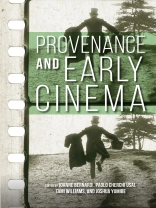Remnants of early films often have a story to tell.
As material artifacts, these film fragments are central to cinema history, perhaps more than ever in our digital age of easy copying and sharing. If a digital copy is previewed before preservation or is shared with a researcher outside the purview of a film archive, knowledge about how the artifact was collected, circulated, and repurposed threatens to become obscured. When the question of origin is overlooked, the story can be lost. Concerned contributors in Provenance and Early Cinema challenge scholars digging through film archives to ask, ‘How did these moving images get here for me to see them?’
This volume, which features the conference proceedings from Domitor, the International Society for the Study of Early Cinema, 2018, questions preservation, attribution, and patterns of reuse in order to explore singular artifacts with long and circuitous lives.
Inhoudsopgave
Domitor Series – Précis
Introduction: Provenance and Early Cinema: From Preservation and Collection to Circulation and Repurposing
Part I: Studying Provenance: From Analog to Digital
1. Film Provenance: A Framework for Analysis
2. Origins: Early Films and Archival Collections
3. From Provenience to Provenance: The Kerstrat d’Hauterives Collection
4. Provenance and Film Historiography: 1910s Films at the George Eastman Museum
5. Issues of Provenance and Attribution for the Canon: Bookending Robert Paul
6. Shattered Provenance in the Digitization of Early Color Films
Part II: Preservation and Collection
7. Dreaming in Color: The Image and the Artifact
8. Where Did the Costumes in Early Cinema Come From?
9. Thinking with Provenance: Drawing Trajectories in the Francis Doublier Collection at the George Eastman Museum
10. Revisiting the Films of Albert Kahn’s Archives de la Planète: A Material Survey
11. The Thanhouser Studio Filmography: Analysis and Extant Prints
12. The Great War at Scale: New Opportunities for Provenance in World War I Collections at the National Archives (NARA)
Part II: Circulation
13. Chicago’s ‘Censored Casualties’ and the Provenance of Archive Prints
14. What Made the Mechanicals Move? Postcards in Transit
15. ‘The End of a Foreign Monopoly’: Bausch and Lomb and the Wartime Provenance of Optical Glass
16. Pathé Films in Brazil: The Archives of ‘Marc Ferrez & Sons’ (1908-1916)
17. Establishing the Provenance of Early Advertising Films: Film Catalogs and the Creation of the Non-theatrical Market
18. A Journey on the World’s Most Northerly Railway: The Renaming and Remaking of Swedish Industrial Films
19. In Search of ‘The Edison Biograph Company’: Film History through Philippine Archives
20. Ownership, Exploitation, Stewardship: Tracking the Footage of the 1911-1913 Australian Antarctic Expedition
Part IV: Repurposing
21. Finding Early Cinema in the Avant-Garde: Research and Investigation
22. Ernie Gehr’s The Collector (2003) and Ernie Gehr the Collector
23. Flicker: Thom Andersen Takes Muybridge to the Movies
24. Provenance on Ice: Frozen Time and the Dawson City Collection
25. Praxis as Media Historiography: The Peep Box’s ‘Expanding View’ as Virtual Reality
26. How Newspaper Novels and Their Illustrations Shaped Japanese Films
27. Archival Object or Object Lesson? Bricolage as Process and as Concept in the Edmundo Padilla Collection
Appendices
28. French Language Essay: Germain Lacasse, La collection de Kerstrat-d’Hauterives, de sa provenience à sa provenance
29. French Language Essay: Priska Morrissey, D’où viennent les costumes du cinéma des premiers temps ?
30. Dryden Theatre Screening Program
Index












